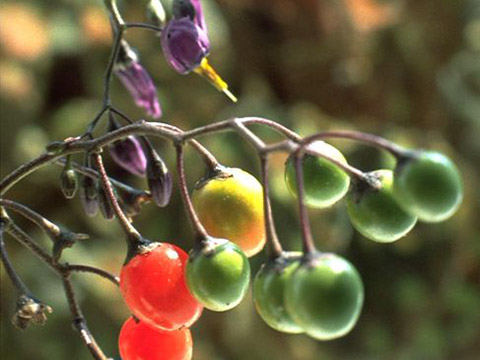Botanical name
Solanum dulcamara L.
Family
Solanaceae
Common name
Bittersweet, Bittersweet nightshade, Woody nightshade, Blue bindweed, Felonwort, Felonwood, Poisonberry, Trailing nightshade, Violet bloom.
Information about the plant
The woody nightshade is widespread in Europe, North Africa, and Asia (as far as Japan and China) and has been introduced to North America. In Europe, it extends northward to Scotland, southern Norway, central Sweden, and southern Finland. It grows in damp thickets, along riverbanks, in riparian forests, on forest slopes, and scree slopes, ascending to the subalpine levels.
The genus name Solanum is derived either from the Latin 'solamen' (= comfort) or from 'solari' (= to soothe), and refers to the soporific and analgesic effect of some Solanum species. There are several explanations for the German name 'Nachtschatten'. Either it originated from an older form of the name 'Nachtschaden' (literally 'nocturnal damage'), which would indicate the toxicity of many species, or it refers to the black berries of some species. It may also refer to the use of the plants in folk medicine to treat nocturnal complaints such as nightmares and moonstroke. The species epithet dulcamara is a combination of the Latin 'dulcis' (= sweet) and 'amarus' (= bitter), and refers to the taste sensations experienced when chewing the stems: the initially bitter taste (of the steroid saponins) is replaced by a sweet taste. The sweet taste then increases with prolonged chewing. This characteristic was also reflected in the German name 'Bittersüßer Nachtschatten'. This change in taste is also described for the leaves and red fruits of the plant.
Woody nightshade is a semi-shrub with a creeping, up to 2 m long basal axis. The stems are climbing or prostrate, herbaceous only in the upper part, otherwise woody. The leaves are stalked and alternate. The long-stalked flowers are arranged in panicle-like clusters; the flowers themselves are very striking and unmistakable with their dark purple petals and stamens fused into a bright yellow tube. The fruits turn red in the final stage, but as they do not all ripen simultaneously, green, orange and red fruits can be observed at the same time.
Woody nightshade is considered a poisonous plant (!) due to its content of poisonous steroid alkaloids. The red berries of the plant are particularly attractive, especially to children. The ripe berries are almost alkaloid-free, as the steroid alkaloids break down as the berries ripen. However, they can still cause nausea and vomiting; larger quantities of unripe berries can trigger serious symptoms of poisoning: severe throat irritation, vomiting, colic, and severe diarrhea. Later symptoms include mydriasis, dizziness, drowsiness, headaches, and visual disturbances up to hallucinations; death can occur due to circulatory collapse or respiratory paralysis.
Medicinally used parts of plants (herbal drug)
The dried, 2- to 3-year-old stems (bittersweet stems - Solani dulcamarae stipites) are used; the stems are collected at the beginning of spring or after the leaves have fallen in late autumn.
Constituents of the herbal drug
Woody nightshade stems contain (poisonous) steroid alkaloids, steroid saponins, and tannins.
Quality of the drug
The pharmacopoeias (Ph. Eur., DAB, DAC) do not specify the quality of woody nightshade stems. A pharmacopoeial monograph on bittersweet stems (Stipites dulcamarae) was contained in the now outdated supplementary volume to DAB 6 (Erg. B. 6).
Medical applications
Recognised medical use
The HMPC has classified woody nightshade stem as a traditional herbal medicinal product (see "Traditional use").
Traditional use
The HMPC has classified woody nightshade stem as a traditional herbal medicinal product (Article 16a of Directive 2001/83/EC). The HMPC concluded that, based on its long-standing use, woody nightshade stem can be used for the relief of symptoms of mild recurrent eczema (itchy, red rash).
Herbal drug preparations in finished dosage forms
Herbal medicines containing comminuted woody nightshade stem are usually available for soaking in water (infusion or decoction) to produce a liquid to be applied to the skin.
Dosage
Finished medicinal product: see patient information leaflet.
Tea: For compresses, soak gauze with warm tea and cover the affected areas of skin with it, then remove after 1 hour. Apply 3 to 5 times a day.
Preparation of a tea
For external use: Boil 1 to 2 g of cut woody nightshade stems with 250 mL of water for 10 minutes, strain, and leave to cool (use it warm).
Notes
Woody nightshade stem should only be used in adults and should not be used if symptoms last for longer than two weeks without seeking advice from a qualified healthcare practitioner. Woody nightshade may be harmful if taken orally, and such use is not covered by the Committee’s conclusions. Detailed instructions on how to use woody nightshade stem medicines and who can use them can be found in the patient information leaflet that comes with the medicine.
Side effects
None known.
Interactions
None known.


